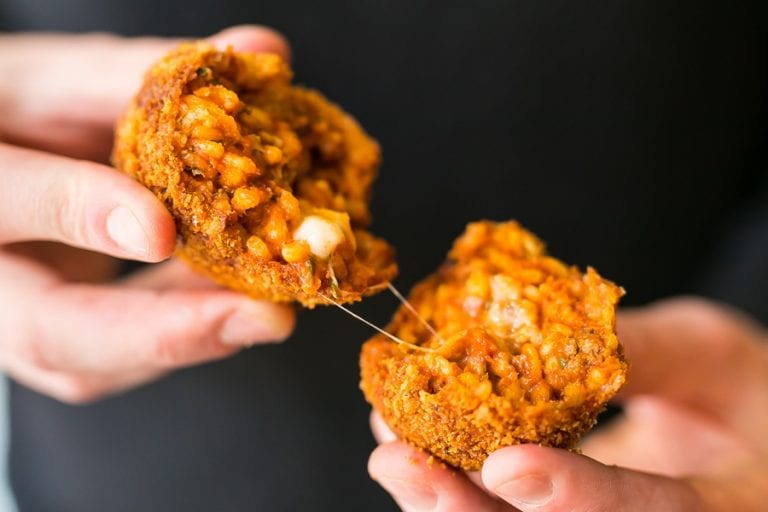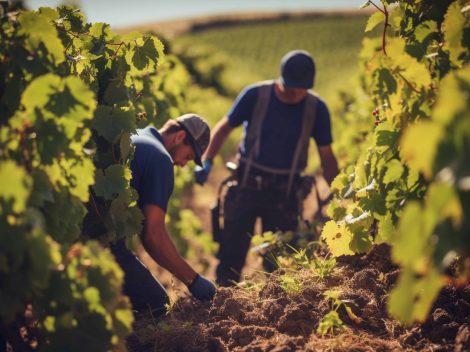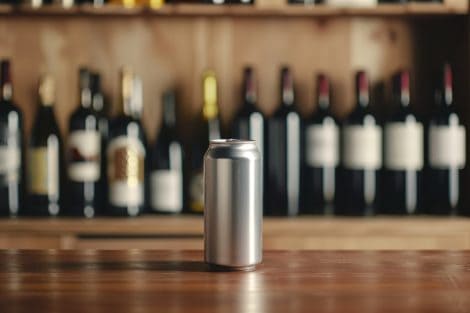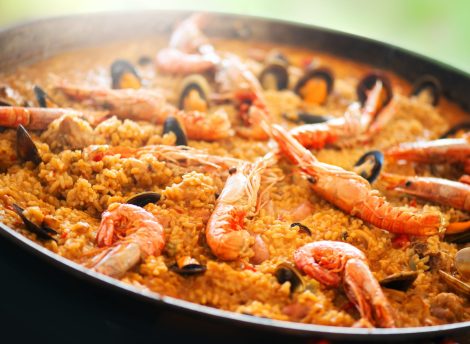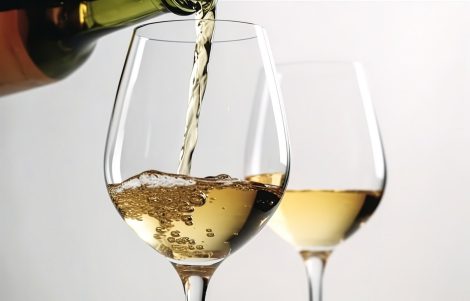We already established why discussing regional cuisine can be tricky (we also explained why), but for convenience sake, we will continue to hold some recipes within the boundaries of the various Italian regions and, where necessary, within city limits. This time we focus on home-cookery in Rome, a land of shepherds, peasants, ancient traditions, strong flavours and recipes that make clever use of leftovers. Think home-cooked succulent recipes such as bucatini all'amatriciana, artichokes alla Romana, preparations using the 'fifth quarter,' roast lamb, chicken with peppers and fresh vegetable sauces such as vignarola. It was difficult choosing only three dishes, but we managed. Here the recipes for supplì, spaghetti carbonara and oxtail 'alla vaccinara.'
Supplì
These are bullet-shaped rice dumplings mixed with offal ragout (as per the original recipe), tomato and a mozzarella filling, to be mandatorily eaten absolutely hot and producing long ribbons of melted cheese. Supplì is the symbol of Roman cuisine, but the name actually has French origins: it appears to derive from the French word 'surprise' with which the French soldiers during the Napoleonic occupation of the late eighteenth century called the fried treat because of the melted mozzarella filling surprise filling. Among other things, this is also the reason why this dish is commonly also called "supplì al telefono". Breaking a supplì in half, the melted mozzarella between the two parts resembles an obsolete telephone chord.
Ingredients for approximately 20 supplì
400 g fine or superfine risotto rice
3 gizzards and 3 chicken livers
300 g tomato passata
1,2 l bone broth
1 onion, minced
3 tbsp. extra-virgin olive oil
1/2 glass dry, white wine
2 tbsp. butter
60 g parmigiano cheese, grated
1 fiordilatte ball, weighing approx. 200 g
2 eggs, beaten
200 g breadcrumbs
Salt and pepper
Olive or peanut oil for frying
Prep time: 60 minutes + 1 hour rest time.
Trim the fat away from the gizzards, rinse and mince them. Heat the oil and sweat the onion. Add the gizzards and brown until the onion is translucent. Deglaze with the wine and once evaporated, pour in the tomato passata, seasoning with salt and pepper.
Lower the heat, cover with a lid and cook for approximately 30 minutes making sure the sauce does not stick to the bottom of the pot. Incorporate the minced chicken livers and simmer for another few minutes. Add the rice and allow it to absorb the flavours of the sauce for a few minutes, mixing well. Next start cooking the rice by adding boiling broth, one ladle at a time. Cook the risotto over vivacious heat until quite al dente. Adjust seasoning, remove the pot from the stove and add the butter and grated cheese, mixing vigorously to obtain a creamy blend. Pour on a large marble surface (or on large flat china dishes) spreading it thinly to cool. Chop the mozzarella ball, if it is very fresh and oozing liquid, you may want to blot some of that moisture with paper towel. Once the rice has completely cooled down. Scoop up a heaped tbsp., stuff the core with a couple pieces of mozzarella and close to completely envelop the filling. Shape the supplì and dunk them in beaten egg, then dredge them in breadcrumbs. Allow the supplì to rest for a couple hours in the fridge before frying them in hot oil (175° C ); blot on paper towel and serve hot.
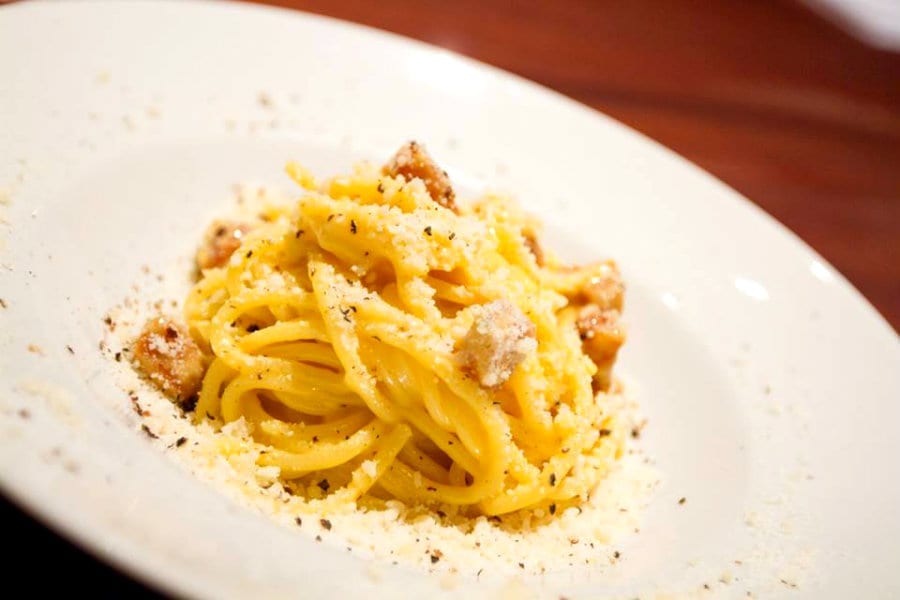 Carbonara by Roscioli, Rome
Carbonara by Roscioli, Rome
Spaghetti Carbonara
The origin of pasta alla carbonara is uncertain, it travels between history and legend. According to some, the dish was invented by the charcoal sellers (woodsmen who went to the Apennines to make charcoal with firewood) inspired by the ancient cacio e ova recipe. According to others, the origin of carbonara is much more recent and linked to the end of WWII, when American soldiers arrived in Italy. They assembled the ingredients available to them which they were most familiar with, ie eggs, bacon and spaghetti. If this thesis were true, the symbolic dish of Roman cuisine was officially invented by Americans!
Ingredients
400 g spaghetti
100 g guanciale cut into 1-inch strips
3 very fresh eggs, beaten
60 g pecorino romano, grated (alternatively, 30 g pecorino + 30 g parmigiano)
1 tbsp. extra-virgin olive oil
Salt and pepper
Render the guanciale by simmering it lightly in a large pan with only a thread of olive oil.
In a bowl combine the beaten eggs with the grated cheese and a pinch of salt.
Cook the spaghetti it plenty of boiling salted water. Drain the pasta al dente and pour it in the pan with the guanciale. Pull off the stove and mix well to incorporate the eggy mix. Season with abundant cracked black pepper and mix well to coat the noodles with the creamy mixture. The eggs will cook with the heat of the pasta but should not set like scrambled eggs. Serve immediately in warm plates.
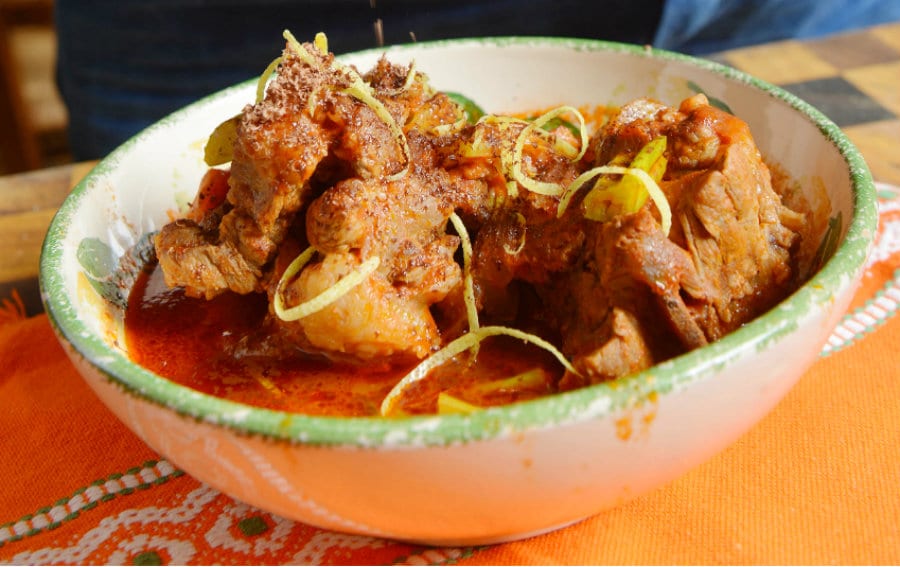 Oxtail alla vaccinara by Giorgione
Oxtail alla vaccinara by Giorgione
Oxtail “alla vaccinara”
Oxtail is part of what in Rome is called the "fifth quarter" that is offal, one of the cornerstones of traditional Roman cuisine. The recipe owes its name to the slaughterhouse workers who lived for the most part in the Testaccio district (home to a famous market nowadays). The workers were partly paid with the tail of the slaughtered animal and other offal cooked by the restaurateurs of the area. The dish is a humble peasant dish, very popular, and –– as per the original recipe –– one that requires the use of cacao powder. The presence of this ingredient should be no surprise, since in papal Rome spices were very widespread and cacao was considered a spice.
Ingredients
1,5 kg oxtail, cut in sections
1 beef cheek (in Rome it's commonly known as 'gaffo'), cubed
1 kg canned tomatoes, crushed
50 g rendered lard
3 tbsp. extra-virgin olive oil
1 glass dry, white wine
1 medium whole celery
1 tbsp. pinenuts
1 tbsp. sultanas
1/2 tbsp. unsweetened cacao
1 glarge onion, minced
1 carrot, minced
1 celery rib, minced
1 sgarlic clove, finely chopped
Parsley, finely chopped
Have your butcher cut the oxtail in sections carving it along the vertebrae. Blanch it in plenty of boiling salted water for approximately 45 minutes, then drain it.
Heat the oil and the lard in a saucepan (preferably earthenware) and use these to lightly simmer the carrot, onion, celery rib, garlic and parsley for a few minutes. When the mirepoix starts to darken, add the oxtail pieces and the beef cheeks. Continue to simmer lightly, turning the pieces browning them evenly.
Add the wine and let it evaporate slowly. Season with salt and pepper, then mix in the crushed canned tomatoes. Cover with a lid and continue cooking over mild heat for approximately three hours.
During this time, occasionally turn the pieces of meat and tail. If necessary, restore moisture by adding a few tbsp. of hot water. Trim the filaments and tougher parts of the whole celery. Chop coarsely and blanch for a few minutes in boiling water. When the oxtail is half cooked, add the blanched celery pieces. Soak the sultanas in lukewarm water, squeeze out the water and add it to the simmering pot at the end, along with the pine nuts and the cacao powder, mixing to blend flavours well for one last quarter of an hour. Let the dish rest for five minutes before serving.
Note: the 3 hours cooking time is an indication, these can vary depending on the age of the animal and thus the toughness of the meat. The meat should fall off the bone at the end of cooking.
Main picture: classic Supplì by Trapizzino in Rome. Ph Alberto Blasetti
translated by Eleonora Baldwin

